The Shetland Islands, located off the northeast coast of Scotland, are home to a diverse range of avian species.
This archipelago, made up of over one hundred islands and stretches over 100 miles, boasts a unique combination of coastal cliffs, rugged heathland, and peat bogs, providing a rich habitat for a variety of birdlife to thrive.
The islands are breeding grounds for an array of seabirds such as puffins, guillemots, razorbills, and kittiwakes, and also attract numerous migrant birds during the spring and autumn seasons.
This article will explore the different birds that can be found in these northern isles, detailing their distinctive characteristics, breeding, and migration behaviors.
1. Common Loon
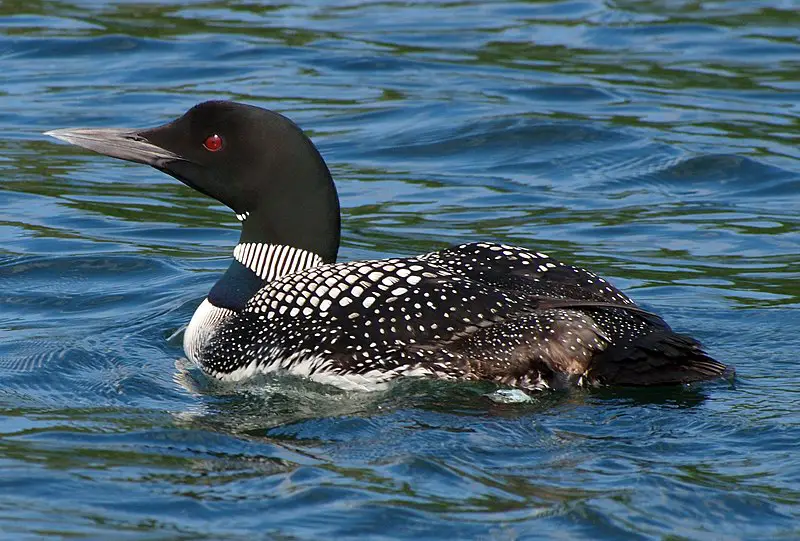
The Common Loon is a beautiful bird found in North America. It has a large black head and neck, with a greenish to purple sheen that stands out against its dark grey upperparts.
The underparts are pure white except for some black on the undertail coverts and vent.
During non-breeding season adults have brown plumage instead of the bright shades they show during breeding season.
They also exhibit unique behaviors such as diving underwater to catch fish or swimming along lakeshores while calling loudly, which is how they got their name “great northern diver”.
With their stunning colors and interesting behavior, it’s no wonder why these birds make up an iconic part of many landscapes across North America.Scientific classification:
| Kingdom | Animalia |
| Phylum | Chordata |
| Class | Aves |
| Order | Gaviiformes |
| Family | Gaviidae |
| Genus | Gavia |
| Species | G. immer |
Also Featured In: Most Common United States Birds, Most Common Songs Birds that Live around You
2. Dunlin

The Dunlin is a small wader, formerly known as part of the stint family. It has dull brown feathers and its name is derived from the dialect word “dunling”.
This bird breeds in Arctic or subarctic regions during summer months, but migrates to warmer climates during winter.
The Dunlin feeds on insects and invertebrates which it finds in mudflats and shallow waters.
During breeding season they form large flocks that can contain thousands of birds. They are also well-known for their impressive synchronized flight patterns that look like a wave moving through the sky.Scientific classification:
| Kingdom | Animalia |
| Phylum | Chordata |
| Class | Aves |
| Order | Charadriiformes |
| Family | Scolopacidae |
| Genus | Calidris |
| Species | C. alpina |
Also Featured In: Most Popular Bird Species in North America, Estuaries Birds
3. Great Skua
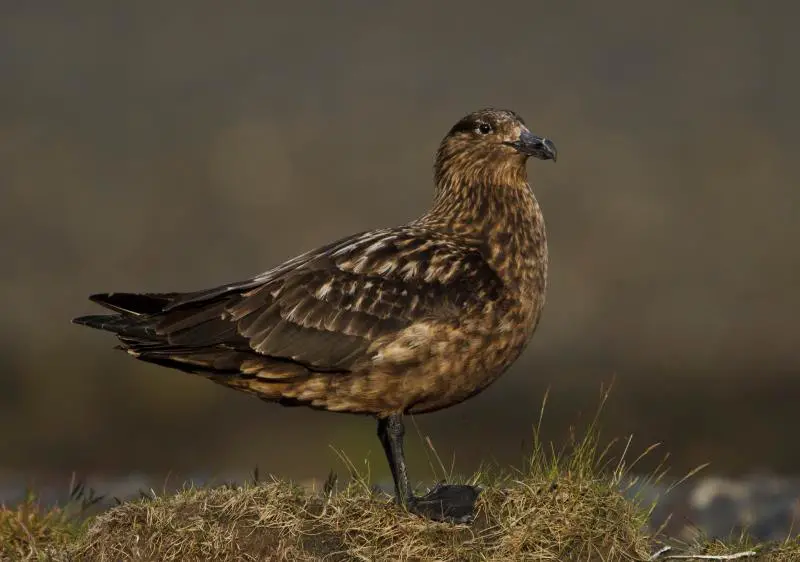
The Great Skua is a large sea bird belonging to the family Stercorariidae, found in areas such as Faroe Islands and Iceland.
It has a size similar to that of herring gulls, with its diet consisting mainly of fish caught at the surface or taken from other birds.
This species was first described by Danish zoologist Morten Thrane Brünnich in 1764 under the name Cath.
They are powerful predators who will sometimes use mobbing tactics against larger prey like gannets and eiders until they give up their catch.
These birds mate for life but may build nests near colonies if there aren’t enough suitable territories available on their own island range.
Although these skuas might seem intimidating due to their fierce nature when protecting young, they can be quite timid around humans so should not be approached too closely.Scientific classification:
| Kingdom | Animalia |
| Phylum | Chordata |
| Class | Aves |
| Order | Charadriiformes |
| Family | Stercorariidae |
| Genus | Stercorarius |
| Species | S. skua |
Also Featured In: Beautiful Brazilian Birds, Birds that Live in Svalbard
4. Common Ringed Plover
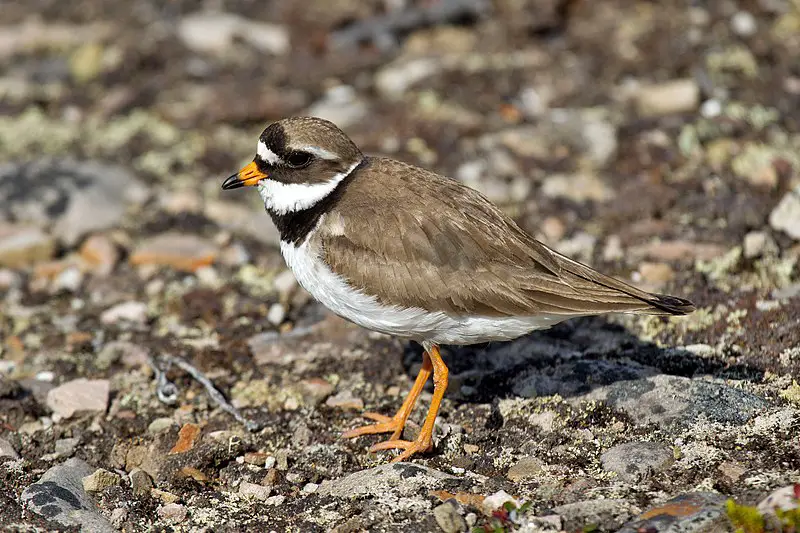
The Common Ringed Plover is a small migratory bird found in Arctic Eurasia. It has yellowish feathers and its Latin name, Charadrius hiaticula, means ‘bird of ravines’.
This species breeds on beaches and tundra during northern summer months before flying south when winter arrives.
Its diet consists mostly of insects which it catches by running along the shoreline or through shallow water with wings spread open to create a shadow that helps catch prey.
The common ringed plover nests in short grasses near water’s edge where they lay two eggs per clutch which hatch within three weeks.
These birds are highly territorial so will often defend their patch fiercely against competitors.Scientific classification:
| Kingdom | Animalia |
| Phylum | Chordata |
| Class | Aves |
| Order | Charadriiformes |
| Family | Charadriidae |
| Genus | Charadrius |
| Species | C. hiaticula |
Also Featured In: Egyptian Birds, Common Birds of Portugal
5. Arctic Tern
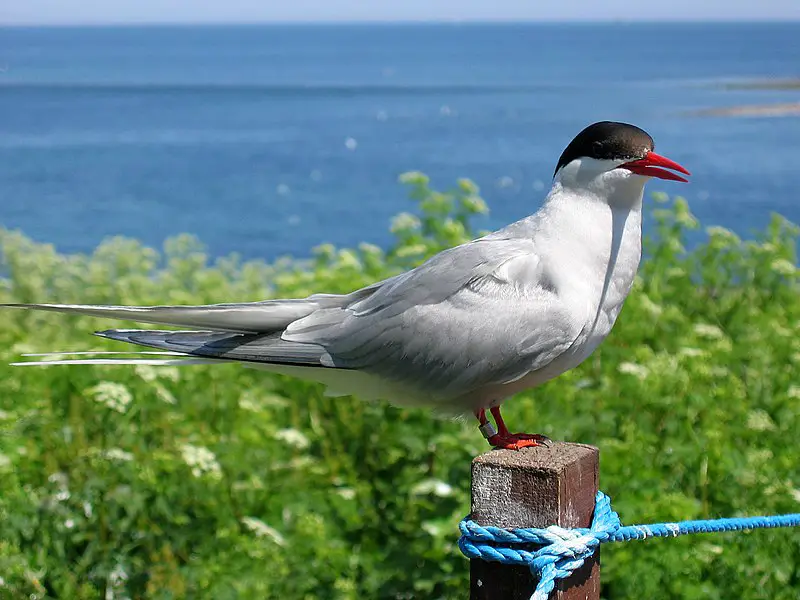
The Arctic tern is an incredible bird that displays a truly remarkable migratory behavior.
It breeds in the northern regions of Europe, Asia and North America during summer before undertaking its migration along a convoluted route to reach the Antarctic for winter.
This species has adapted extremely well to its environment – it can fly very long distances while navigating with ease thanks to their excellent eyesight.
Furthermore, they are able to survive in temperatures as low as -40 degrees Celsius.
The Arctic Tern is also known for being one of the longest living birds on Earth; some have been recorded living up to 30 years old.Scientific classification:
| Kingdom | Animalia |
| Phylum | Chordata |
| Class | Aves |
| Order | Charadriiformes |
| Family | Laridae |
| Genus | Sterna |
| Species | S. paradisaea |
Also Featured In: Birds of United Kingdom, Tundra Birds
6. Cormorants
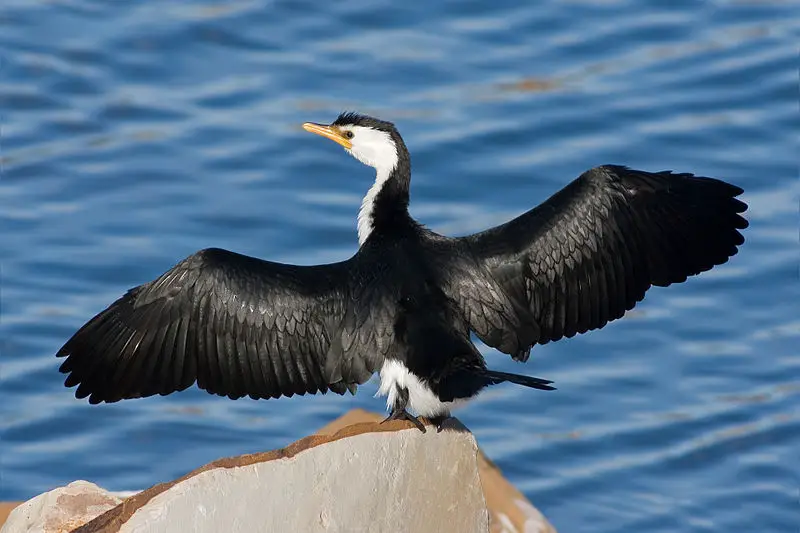
Cormorants are a family of aquatic birds found around the world. They include 40 species, such as great cormorants and common shags.
In Britain, these two species are the most commonly seen in their natural habitats.
Cormorants have long necks, webbed feet and can be identified by their glossy black feathers which they use to help them swim through water with ease as they hunt for food like fish or crustaceans.
They have an impressive wingspan often reaching up to five feet across when fully extended.
Despite being strong swimmers, these birds also enjoy spending time perched on rocks near rivers or shorelines where they will preen themselves in order to keep clean and dry during cooler weather conditionsScientific classification:
| Kingdom | Animalia |
| Phylum | Chordata |
| Class | Aves |
| Order | Suliformes |
| Family | Phalacrocoracidae Reichenbach, 1850 |
Also Featured In: Most common Birds in France, Turkey Birds You Should Know
7. Eurasian Skylark
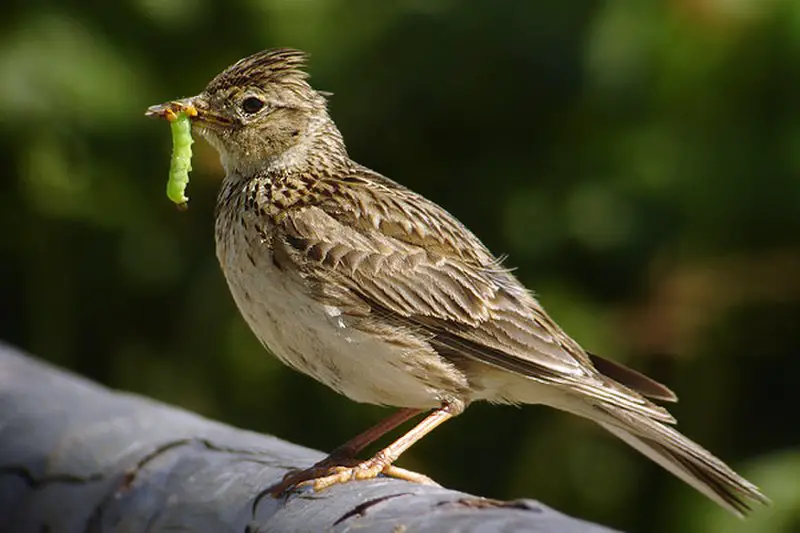
The Eurasian skylark is a medium-sized bird belonging to the lark family, Alaudidae. It inhabits open areas such as farmland and heathland across Europe and the Palearctic region.
The most notable characteristic of this species is its male’s song which is delivered in an impressive hovering flight from heights ranging between 50 – 100 metres (160 – 330 ft).
This beautiful bird has been introduced to New Zealand, Australia and Hawaii Islands too.
Its main diet consists of insects but it also feeds on seeds, grains and some vegetation during wintertime when food sources become scarce.
The males are known for their elaborate courtship display involving high flights with trills that can be heard up to 2 km away.Scientific classification:
| Kingdom | Animalia |
| Phylum | Chordata |
| Class | Aves |
| Order | Passeriformes |
| Family | Alaudidae |
| Genus | Alauda |
| Species | A. arvensis |
8. Red-Throated Loon
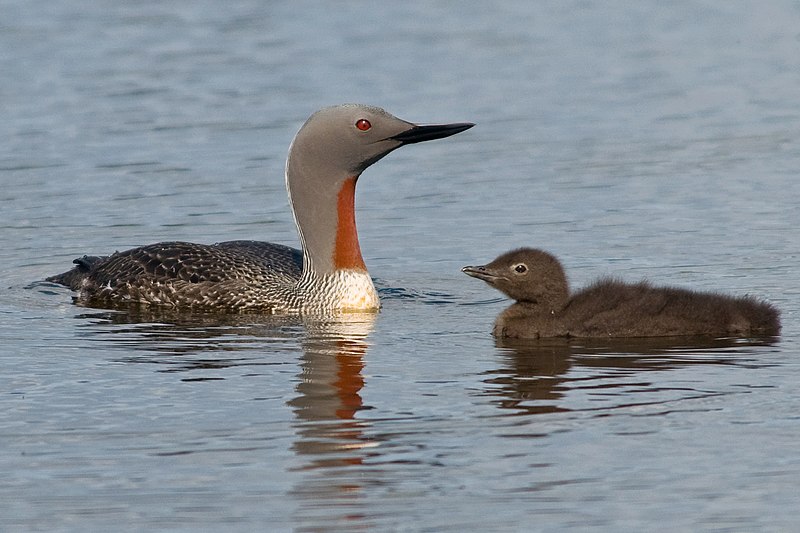
The Red-throated Loon is a migratory bird found in the northern hemisphere, with its breeding grounds primarily located in Arctic regions and wintering spots near coastal waters.
With an average length of 55 – 67 cm (22 – 26 inches), it’s the smallest member of the loon or diver family.
Its namesake comes from its bright red throat patch which contrasts against its white underside and grey back.
This species has adapted to life on icy seas; they are strong swimmers with powerful wings for long flights over open water when migrating seasonally.
Their diet consists mostly of fish but can also include crustaceans, molluscs, amphibians and insects depending on availability.Scientific classification:
| Kingdom | Animalia |
| Phylum | Chordata |
| Class | Aves |
| Order | Gaviiformes |
| Family | Gaviidae |
| Genus | Gavia |
| Species | G. stellata |
Also Featured In: Native South Korean Birds, Italian Birds You Should Know
9. Northern Gannet
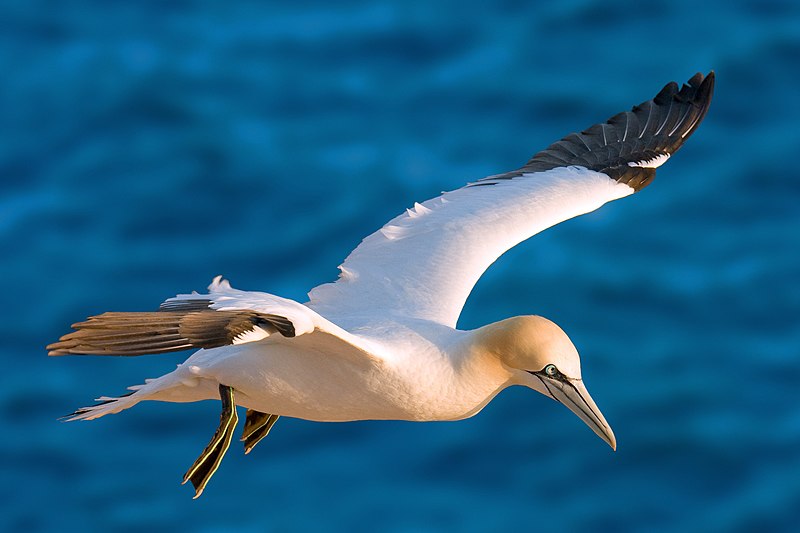
The Northern Gannet is the largest species of seabird in the northern Atlantic, with a white body and long neck.
It has yellowish head feathers and black tipped wings that can reach up to 6 feet across when fully extended.
The beak is large and orange-yellow in color. This bird breeds along western Europe’s coasts as well as northeastern North America.
They forage for fish by plunging into the sea from high above, making them an impressive sight to behold on any given day.
Their diet consists mainly of herring, mackerels or sand eels which they catch midair after diving at speeds reaching over 100 miles per hour.
With their striking features these birds are truly majestic creatures that have been around since prehistoric times – a testament to their hardiness and adaptability.Scientific classification:
| Kingdom | Animalia |
| Phylum | Chordata |
| Class | Aves |
| Order | Suliformes |
| Family | Sulidae |
| Genus | Morus |
| Species | M. bassanus |
Also Featured In: Birds found in portugal, Birds Live in Tunisia
10. European Shag
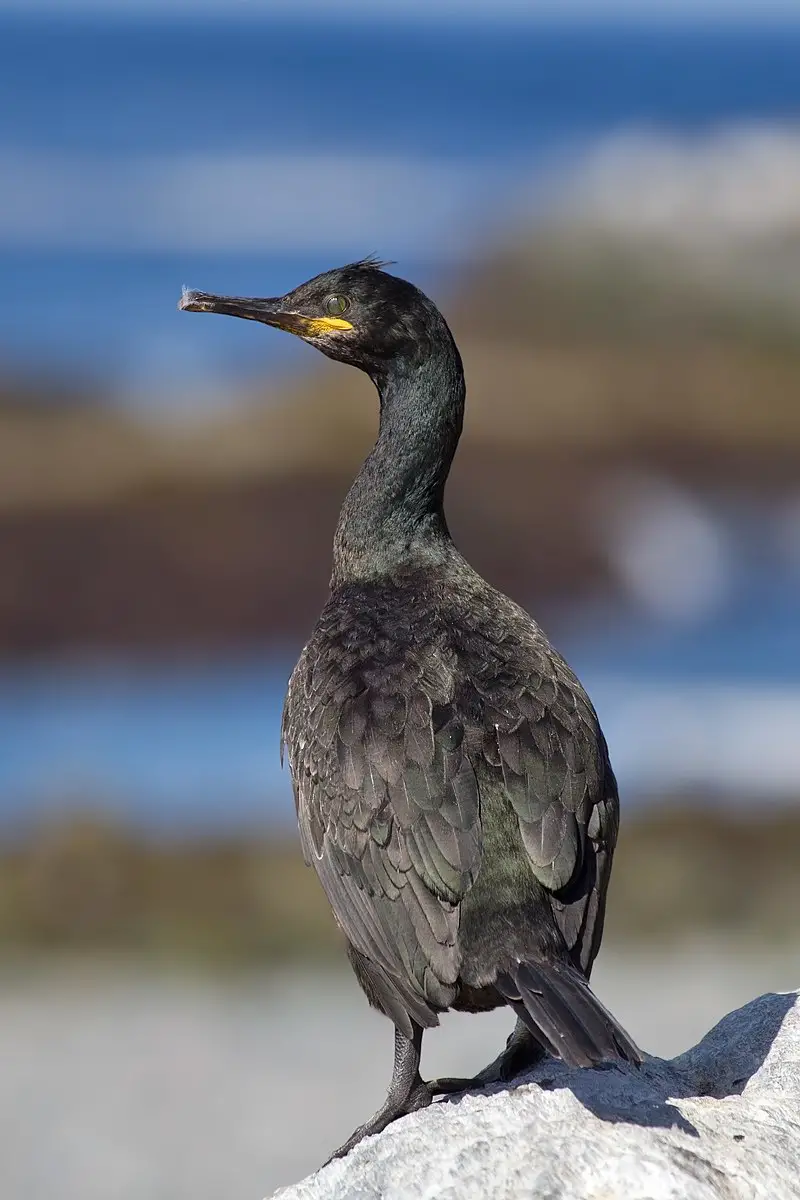
The European shag, or common shag, is a species of cormorant found in western and southern Europe, southwest Asia and north Africa. It usually winters in its breeding range except for the northernmost birds.
The bird has an unmistakable look with it’s greenish blue feathers on top of its head while having white underparts along with some black stripes over them.
Its long neck helps distinguish it from other cormorants as well as provide great sight while searching for food beneath the sea surface.
This seabird mainly feeds off fish but also eats crustaceans occasionally when available near their nesting grounds which are usually located around rocky coastlines close to open water bodies like seas and oceans.Scientific classification:
| Kingdom | Animalia |
| Phylum | Chordata |
| Class | Aves |
| Order | Suliformes |
| Family | Phalacrocoracidae |
| Genus | Gulosus Montagu, 1813 |
| Species | G. aristotelis |
Also Featured In: Feathered Wonders of the Farne Islands: A Bird Watcher’s Paradise,
11. Oystercatchers
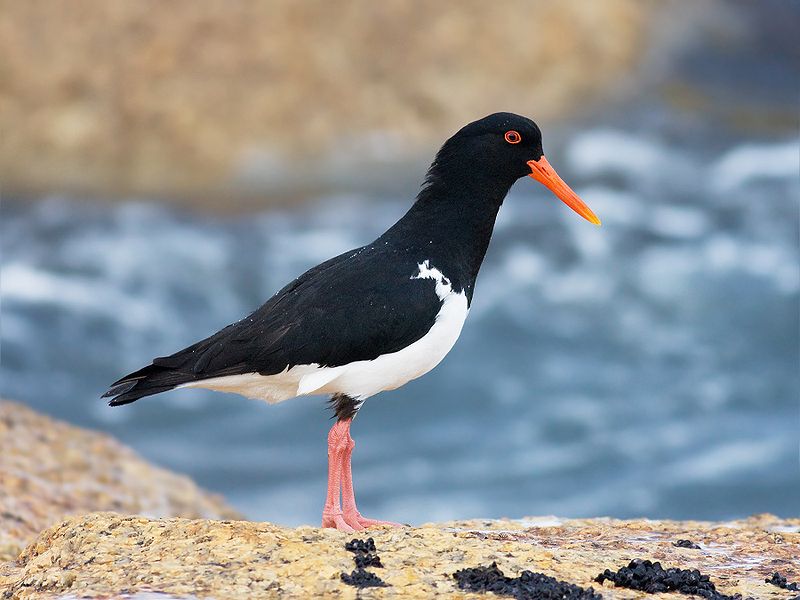
Oystercatchers are a family of waders forming the Haematopodidae, with one genus; Haematopus.
They live in coastal regions around the world excluding both polar and some tropical areas of Africa & South East Asia.
Eurasian, South Island & Magellanic oystercatcher species also breed far inland – breeding grounds being found much deeper than other members of the family.
They have long beaks used to feed on molluscs such as mussels, clams and oysters which they crack open using their strong bills.
Oystercatchers are usually quite vocal birds making various loud calls when disturbed or alarmed.
The males tend to display more brightly coloured plumage compared to females who share similar brown/black hues for camouflage purposes during nesting season.Scientific classification:
| Kingdom | Animalia |
| Phylum | Chordata |
| Class | Aves |
| Order | Charadriiformes |
| Suborder | Charadrii |
| Family | Haematopodidae Bonaparte, 1838 |
| Genus | Haematopus Linnaeus, 1758 |
Also Featured In: Best Birds Watching in Austria, Native Birds of Kazakhstan
12. Eurasian Whimbrel
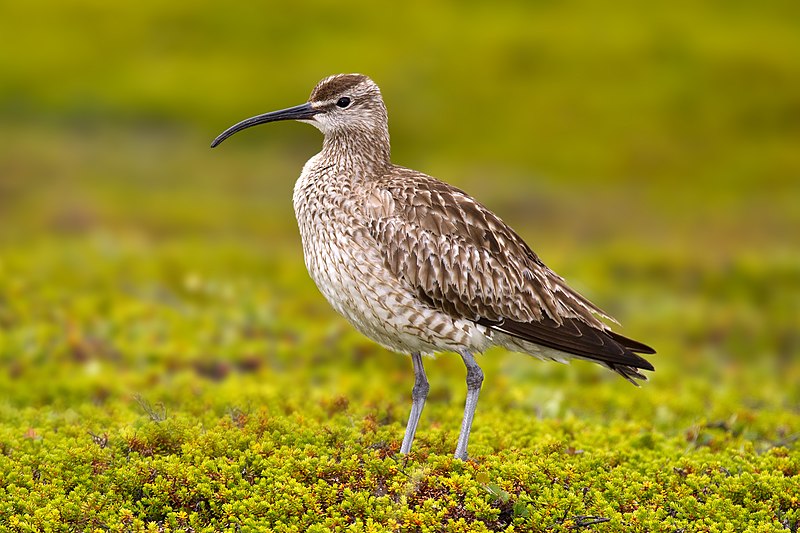
Eurasian Whimbrels are a species of wading bird commonly found in subarctic regions of Europe and Asia.
They have white rumps, long curved bills, brown wings and backs with light streaking on the lower breast.
These birds feed mainly on crustaceans, mollusks or worms they find while probing in the mud during low tide.
During breeding season they can be seen nesting near coastal areas or wetlands where food is plentiful.
This species has recently been split from Hudsonian whimbrels but some authorities still consider them to be one species due to their similarities which includes migration patterns as well as habitat preferences.
Eurasian whimbrels are an important part of many ecosystems because they help control insect populations by eating larvae before it can cause damage to crops or vegetation nearby.Scientific classification:
| Kingdom | Animalia |
| Phylum | Chordata |
| Class | Aves |
| Order | Charadriiformes |
| Family | Scolopacidae |
| Genus | Numenius |
| Species | N. phaeopus |
Also Featured In: Singapore Birds, Galapagos Birds You Should Know
13. Whooper Swan
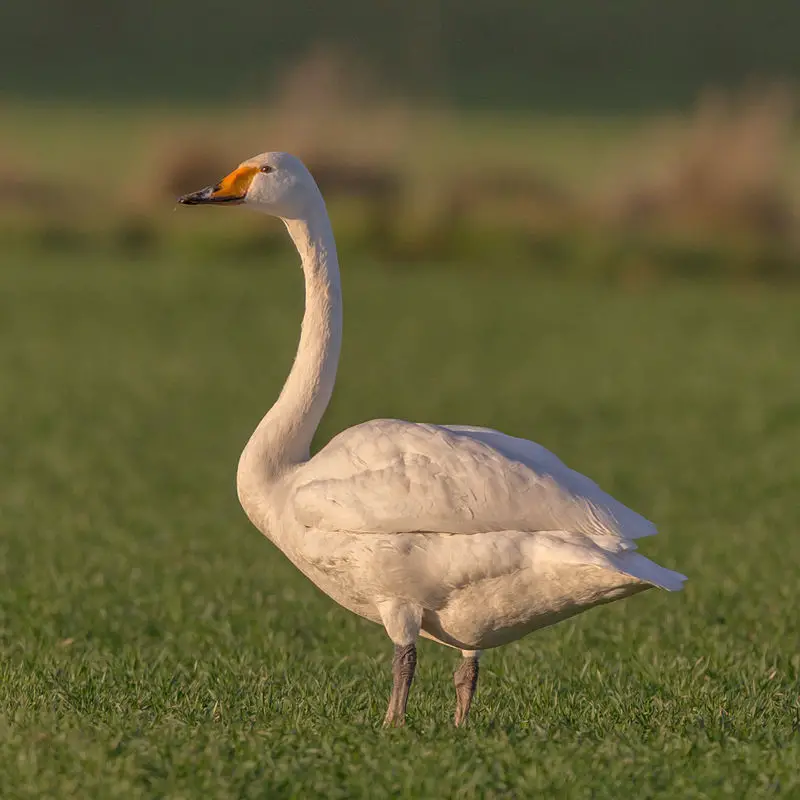
The whooper swan is a majestic bird native to the northern hemisphere. Its wingspan can reach up to 2 meters and it has distinctively curved neck and beak, along with black legs and feet.
It is the Eurasian counterpart of its North American cousin, the trumpeter swan, both belonging to genus Cygnus.
Historically known as “the Elk” or “Hooper” by ornithologists in 1676 according to Francis Willughby and John Ray’s Ornithology , this species of wild swans are often seen gracefully flying over lakes with their long necks outstretched while honking loudly.Scientific classification:
| Kingdom | Animalia |
| Phylum | Chordata |
| Class | Aves |
| Order | Anseriformes |
| Family | Anatidae |
| Genus | Cygnus |
| Species | C. cygnus |
Also Featured In: Birds You’ll Find in Hokkaido, Native Birds of North Uist
14. Red-Breasted Merganser
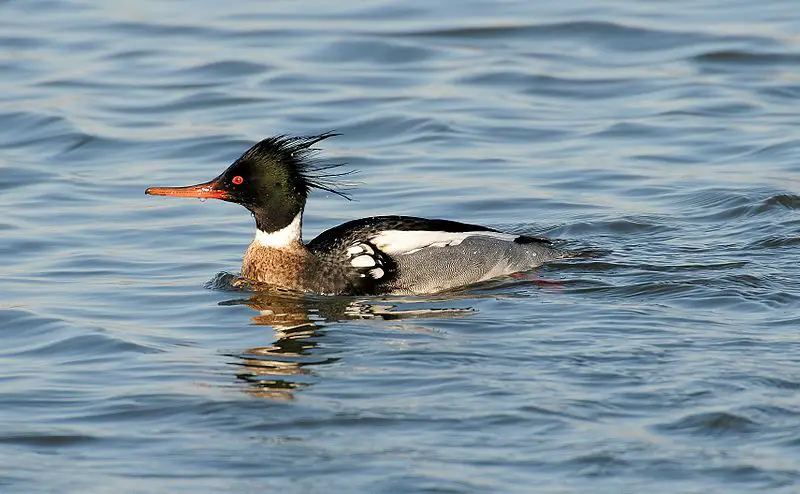
The Red-breasted merganser is a diving duck, part of the sawbills family. It was first described in 1758 by Carl Linnaeus with its Latin name “Mergus Serrator” meaning sawyer or cutter.
With their red breast feathers and black heads, these birds are easy to spot when they’re near water bodies such as lakes and rivers hunting for fish.
They also feed on crustaceans and mollusks that they catch underwater.
During breeding season, the males develop white patches around their eyes making them even more distinct from other species of ducks.
The Red-breasted Mergansers’ population numbers have been declining over recent years due to habitat loss caused by human activities like construction projects close to wetlands where these birds live but conservation efforts can help protect this majestic bird’s future generations.Scientific classification:
| Kingdom | Animalia |
| Phylum | Chordata |
| Class | Aves |
| Order | Anseriformes |
| Family | Anatidae |
| Genus | Mergus |
| Species | M. serrator |
Also Featured In: Kuwait Birds, Common Birds of West Caicos
15. European Golden Plover
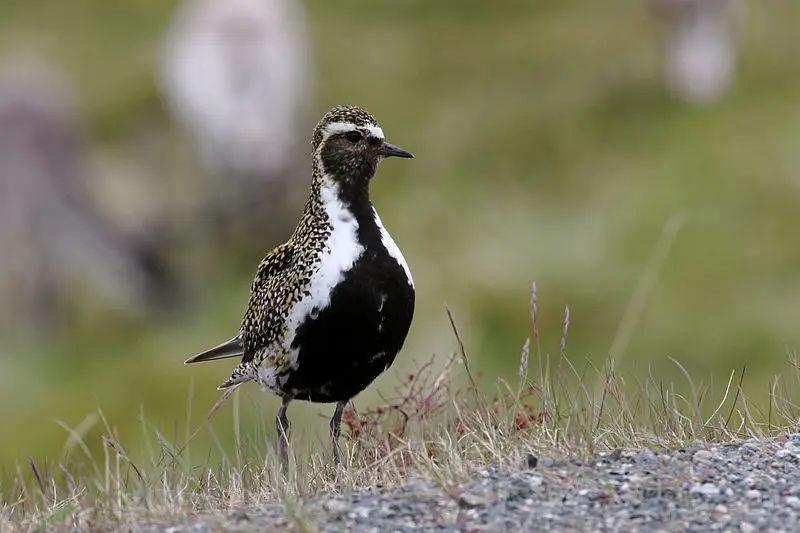
The European golden plover is a large bird that breeds in temperate Eurasia. It has an attractive golden-brown plumage, with black and white markings on its wings and back.
Its long legs are yellowish at the base of their tarsi, while its bill is light grey or pinkish in colour.
During winter months it migrates to Africa where it can be spotted along grasslands and dry plains near water sources such as lakes and rivers.
The species feeds mostly on insects, seeds and small invertebrates found on the ground during breeding season but also eats some berries when available.
They form flocks which help them protect against predators like hawks by providing better visibility for each other from above.
These birds make loud calls upon arrival at their nesting grounds before performing spectacular courtship displays involving flying high into the sky then rapidly diving down again.Scientific classification:
| Kingdom | Animalia |
| Phylum | Chordata |
| Class | Aves |
| Order | Charadriiformes |
| Family | Charadriidae |
| Genus | Pluvialis |
| Species | P. apricaria |
Also Featured In: Iceland birds, Birds That Live in Anglesey
16. Razorbill
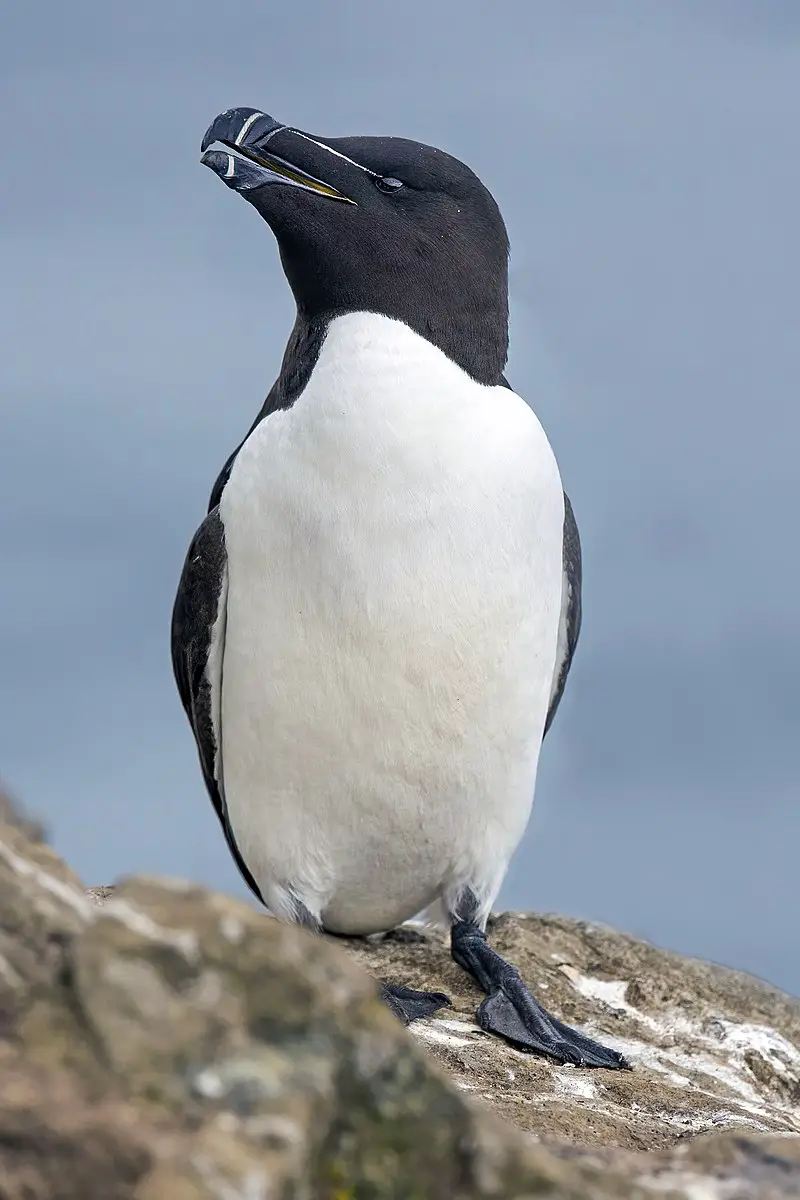
The Razorbill is a seabird of the family Alcidae and is closely related to the extinct great auk. It lives in subarctic waters of the Atlantic Ocean, primarily black with white underside and both male and female look identical.
They have long pointed wings which help them dive underwater for their food that consists mainly of fish and crustaceans.
Usually they form large colonies on cliffs or rocky islands but can also be found solitary during breeding season when pairs nest together in crevices or rock ledges near sea level.
During winter they migrate southwards into open water areas where they stay until spring arrives again before returning back to breed once more.
The razorbill’s population has been declining due to human activity such as overfishing so conservation efforts are being made by governments across Europe in order to protect this species from extinction.Scientific classification:
| Kingdom | Animalia |
| Phylum | Chordata |
| Class | Aves |
| Order | Charadriiformes |
| Family | Alcidae |
| Genus | Alca |
| Species | A. torda |
Also Featured In: Birds that Live in the Ocean , Common Cornwall Birds
17. Snow Bunting
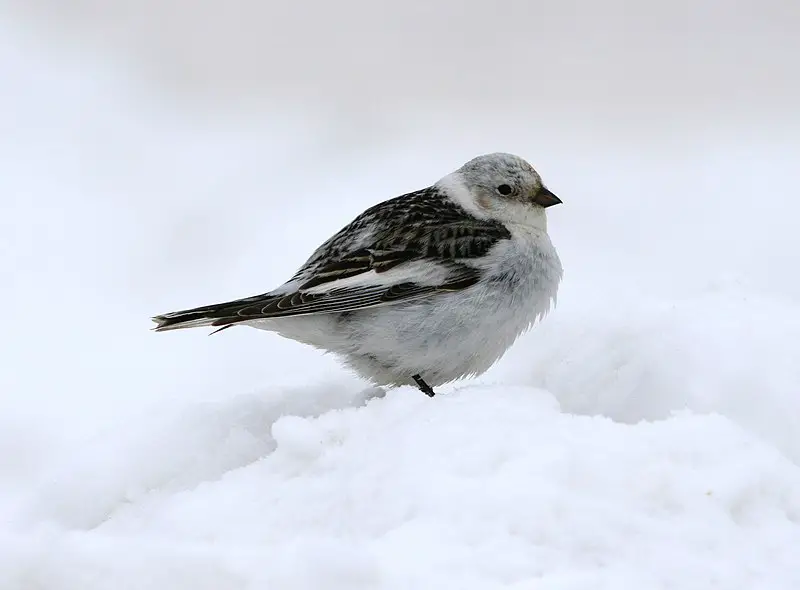
The snow bunting is a small and colourful passerine bird found in the Arctic regions of the northern hemisphere.
With its bright white feathers, black markings on its wings and tail, it stands out amongst other birds that inhabit these cold climates.
This species has adapted well to surviving in this harsh environment; they nest under boulders or rocks so their eggs are shielded from predators and blizzards alike.
They feed mainly on insects during summer months but switch to seeds when winter arrives as they seek food sources which will not freeze over with ice.
The snow bunting is an important part of the local ecosystem due to providing sustenance for larger animals such as foxes and owls who rely upon them for survival throughout wintertime.Scientific classification:
| Kingdom | Animalia |
| Phylum | Chordata |
| Class | Aves |
| Order | Passeriformes |
| Family | Calcariidae |
| Genus | Plectrophenax |
| Species | P. nivalis |
Also Featured In: Most Common Winter Birds, Flocks Birds around Us
18. Merlin
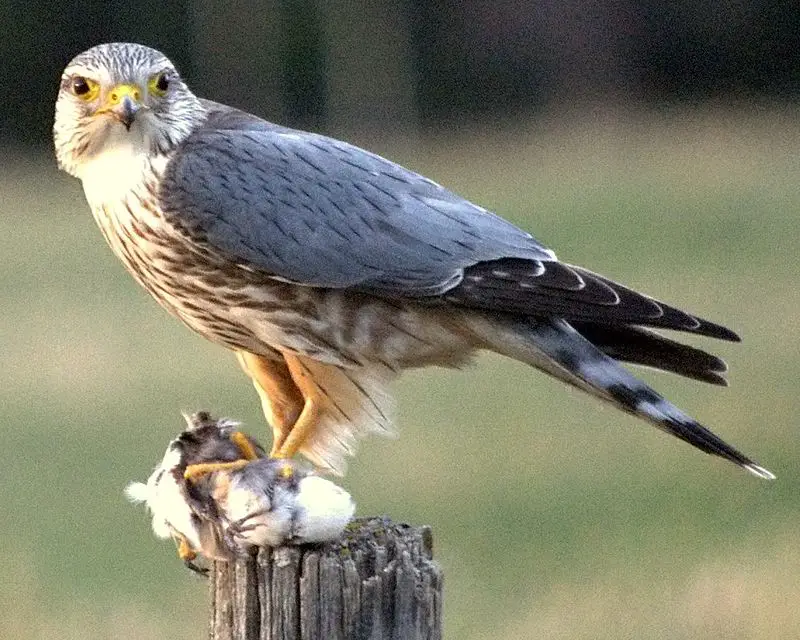
The Merlin is a small species of falcon found in the Northern Hemisphere. It has many subspecies across North America and Eurasia, and was once known as a Pigeon Hawk in North America.
Merlins breed mainly during summer months but some migrate to subtropical or northern tropical regions for winter season.
Males have wingspans ranging between 53-58 centimeters while females have slightly larger wingspan of 60-65 centimeters.
These birds are powerful fliers with fast aerial pursuits that can reach up to 50 mph.
Their diet consists mainly of insects, small mammals and other small birds which they hunt using their keen vision from high altitudes followed by swift dives down towards its prey at incredible speeds.
The Merlin continues to be an iconic symbol amongst bird enthusiasts due to its majestic beauty despite facing habitat loss around the world due to human activities such as deforestation and urbanization.Scientific classification:
| Kingdom | Animalia |
| Phylum | Chordata |
| Class | Aves |
| Order | Falconiformes |
| Family | Falconidae |
| Genus | Falco |
| Species | F. columbarius |
Also Featured In: Falcons Species, Most Common Scotland Birds
19. Puffins
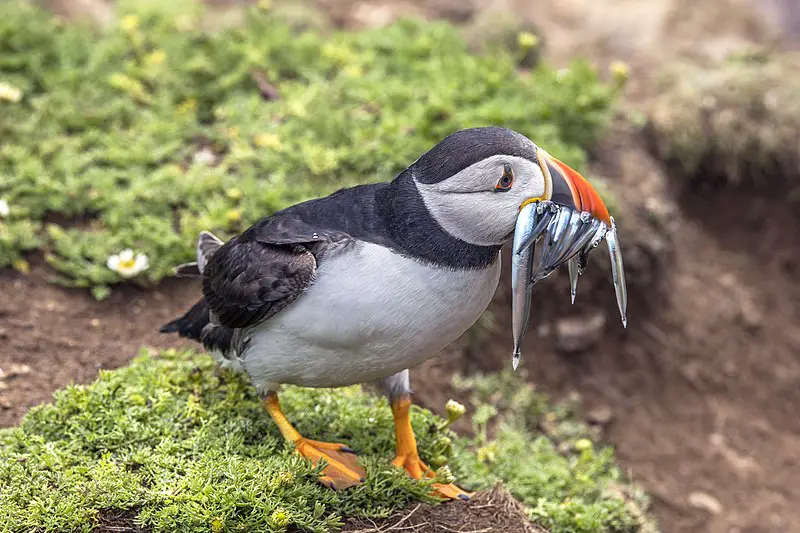
Puffins are small seabirds that belong to the bird genus Fratercula. They primarily feed by diving into the water and breed in colonies on coastal cliffs or offshore islands.
They can nest in crevices among rocks or in burrows in the soil. There are three species of puffins, with two found in the North Pacific Ocean and one in the Atlantic Ocean.
The tufted puffin and horned puffin are North Pacific species, while the Atlantic puffin is the only puffin species found in the Atlantic Ocean.
These birds have colorful beaks that are often compared to clowns’ faces, making them a popular sight among birdwatchers.
Puffins are fascinating creatures that have long been the subject of fascination and study among the scientific community.Scientific classification:
| Kingdom | Animalia |
| Phylum | Chordata |
| Class | Aves |
| Order | Charadriiformes |
| Family | Alcidae |
| Tribe | Fraterculini |
| Genus | Fratercula Brisson, 1760 |
Also Featured In: Birds You’ll Find in the Sea, Famous Paintings Birds
20. Fulmars
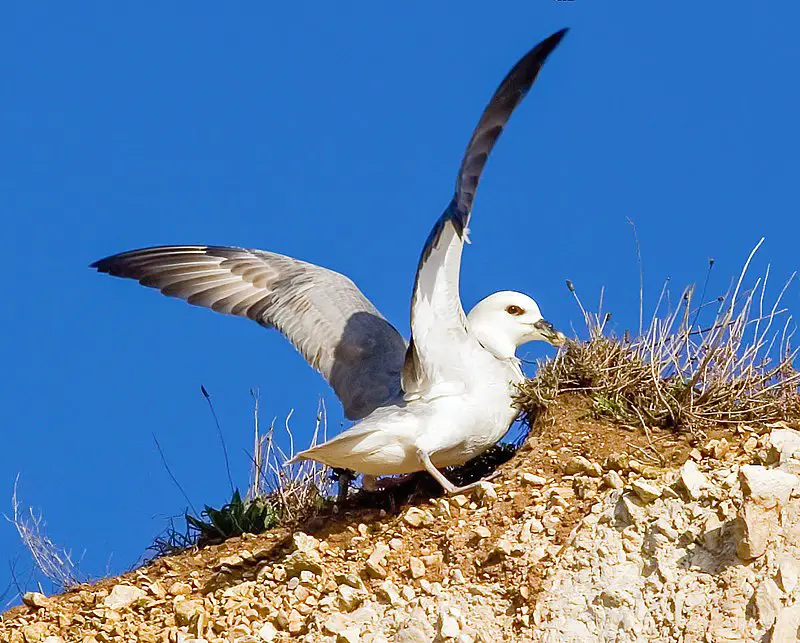
Fulmars are seabirds that belong to the Procellariidae family. They have two current species and two previous fossil species. They look like seagulls, but their flight and tube noses make them distinctive.
Fulmars lay one or two eggs on a ledge of bare rock or on a grassy cliff during breeding season. They nest on cliffs.Scientific classification:
| Kingdom | Animalia |
| Phylum | Chordata |
| Class | Aves |
| Order | Procellariiformes |
| Family | Procellariidae |
| Genus | Fulmarus Stephens, 1826 |
Also Featured In: Birds of Orkney, Birds of Farne Islands
21. Red-Necked Phalarope
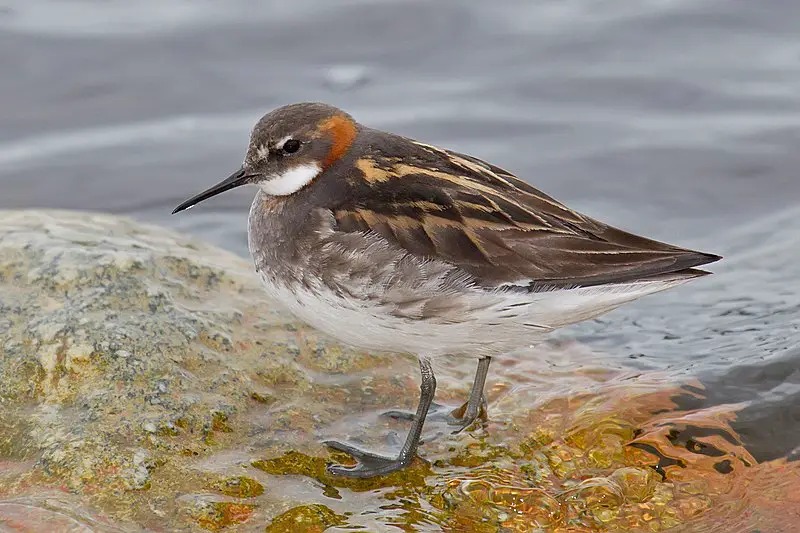
The Red-necked phalarope is a small wading bird that breeds in the Arctic regions of North America and Eurasia. It is also known as the Northern phalarope and Hyperborean phalarope.
Unlike other wading birds, it spends its winters at sea on tropical oceans, making it a migratory bird.
In 1743, the English naturalist George Edwards described this bird and included an illustration.
The Red-necked phalarope is known for its unique feeding behavior, where it spins in circular motions to create a vortex in the water, which brings food to the surface. This bird has a red neck, gray back, white belly, and a straight, thin beak.
During breeding season, the female takes on more vibrant colors, while the male incubates the eggs and cares for the chicks.
The Red-necked phalarope is a fascinating bird with unique characteristics that make it stand out among other wading birds.Scientific classification:
| Kingdom | Animalia |
| Phylum | Chordata |
| Class | Aves |
| Order | Charadriiformes |
| Family | Scolopacidae |
| Genus | Phalaropus |
| Species | P. lobatus |
Also Featured In: Belarus Birds You Should Know, Birds that Live in Greenland
22. Twite
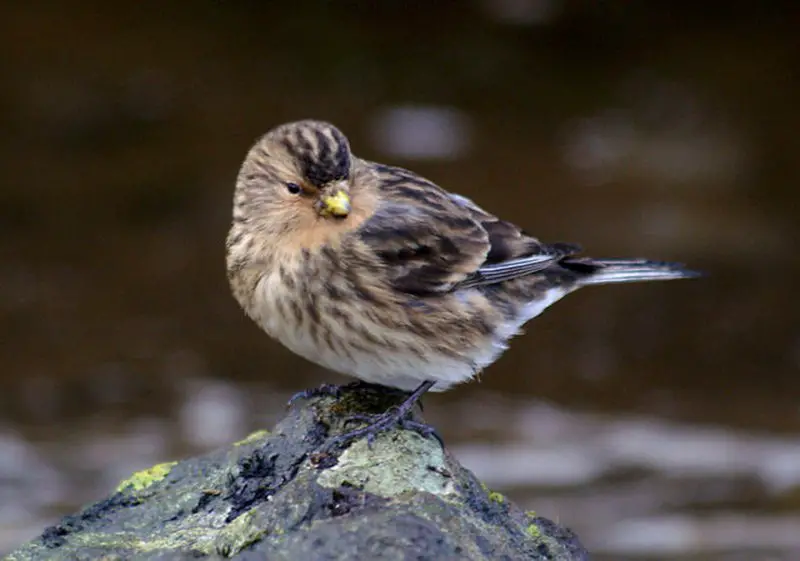
The Twite bird is a small brown passerine bird belonging to the finch family. It is similar in size and shape to a linnet bird.
However, it lacks the red head patch and breast shown by the linnet and the redpolls.
The Twite bird is brown streaked with black above and has a pink rump. The bird’s underparts are buff to whitish, streaked with brown.
The conical bill of the bird is yellow in color. The Twite bird is approximately 13 to 13.5 cm in length.Scientific classification:
| Kingdom | Animalia |
| Phylum | Chordata |
| Class | Aves |
| Order | Passeriformes |
| Family | Fringillidae |
| Subfamily | Carduelinae |
| Genus | Linaria |
| Species | L. flavirostris |
Also Featured In: Armenian Birds You Should Know, Birds of Ladakh
23. Northern Wheatear

The Northern Wheatear is a small migratory bird found in Europe, North, and Central Asia. Formerly classified as a member of the thrush family, it is now considered an Old World flycatcher.
These insectivorous birds breed during the summer months and migrate long distances during the winter season.
They are the most widespread of the Oenanthe wheatear genus. With distinctive black and white markings and a slender body, they are easy to identify.
The Northern Wheatear is known for its acrobatic ability, often seen catching insects mid-air. Males often have striking blue-grey wings and a slate-blue head, while females have brown plumage with a slight peach hue.
Their migration patterns have made them a popular bird for birdwatchers, with sightings occurring in various countries such as Iceland, the UK, and Russia.Scientific classification:
| Kingdom | Animalia |
| Phylum | Chordata |
| Class | Aves |
| Order | Passeriformes |
| Family | Muscicapidae |
| Genus | Oenanthe |
| Species | O. oenanthe |
Also Featured In: Flight Birds You Should Know, Moorland Birds You Need to Know
24. Meadow Pipit
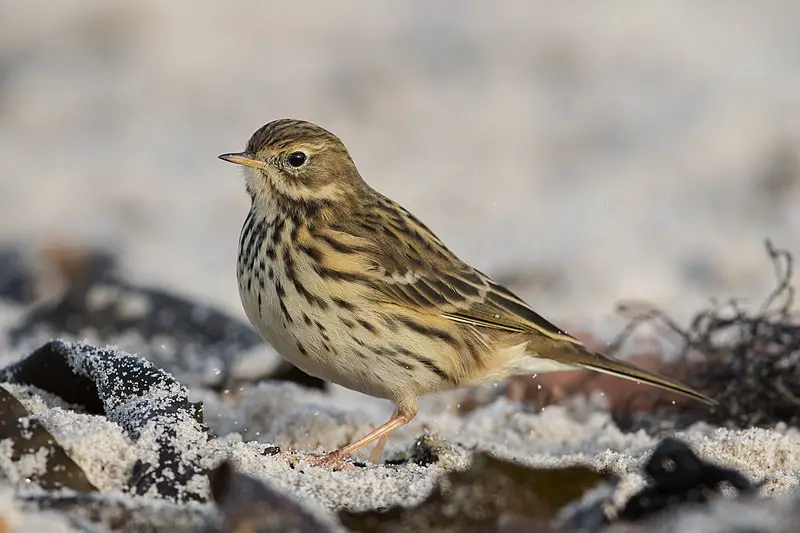
The Meadow pipit is a small bird that is found in the Palearctic region. It breeds in various parts of the region, including southeastern Greenland, Iceland, and central France.
The bird also inhabits areas east of the Ural Mountains, and a small isolated population can be found in the Caucasus Mountains. The Meadow pipit is a migratory bird and travels extensively during this time.
It winters in different parts of southern Europe, North Africa, and southwest Asia. Due to its size and active behavior, it is known to be a difficult bird to locate in open grasslands and meadows.
The Meadow pipit feeds on insects and other small invertebrates and has a melodious song.
Although the bird is widespread, its populations have been affected by changes in agricultural practices, and urbanization.Scientific classification:
| Kingdom | Animalia |
| Phylum | Chordata |
| Class | Aves |
| Order | Passeriformes |
| Family | Motacillidae |
| Genus | Anthus |
| Species | A. pratensis |